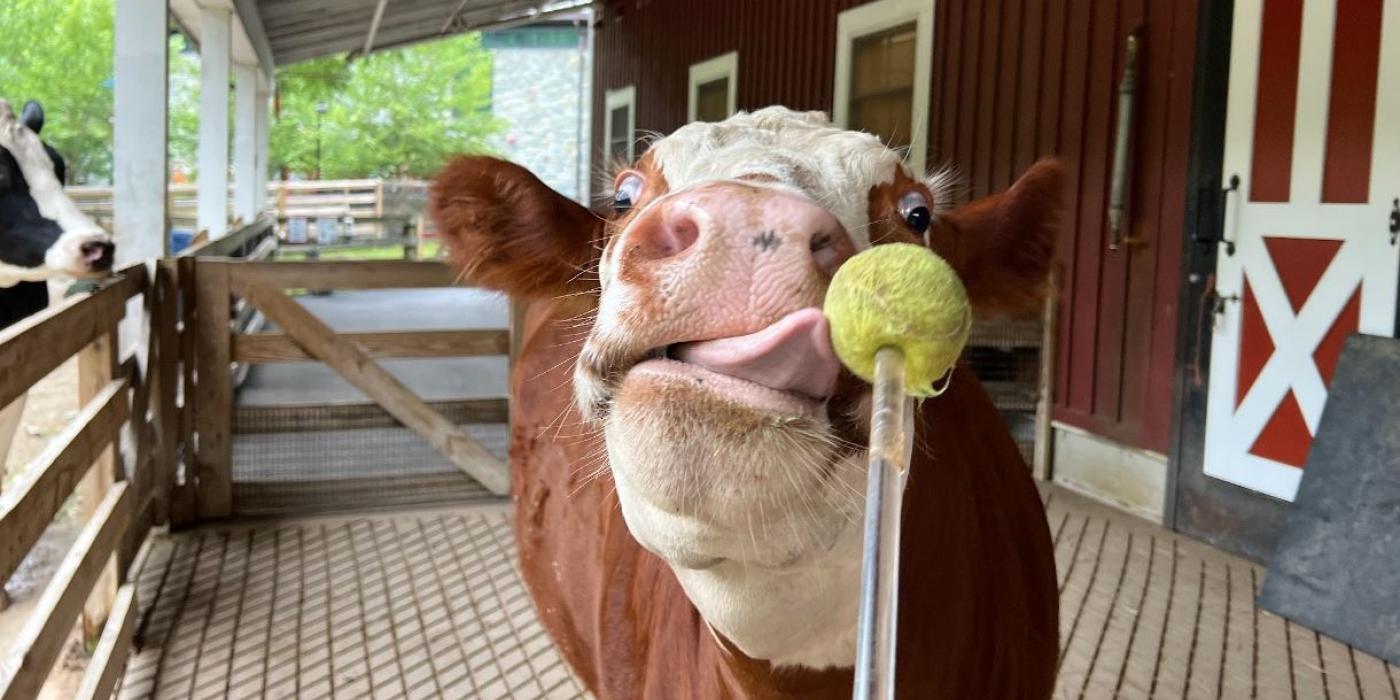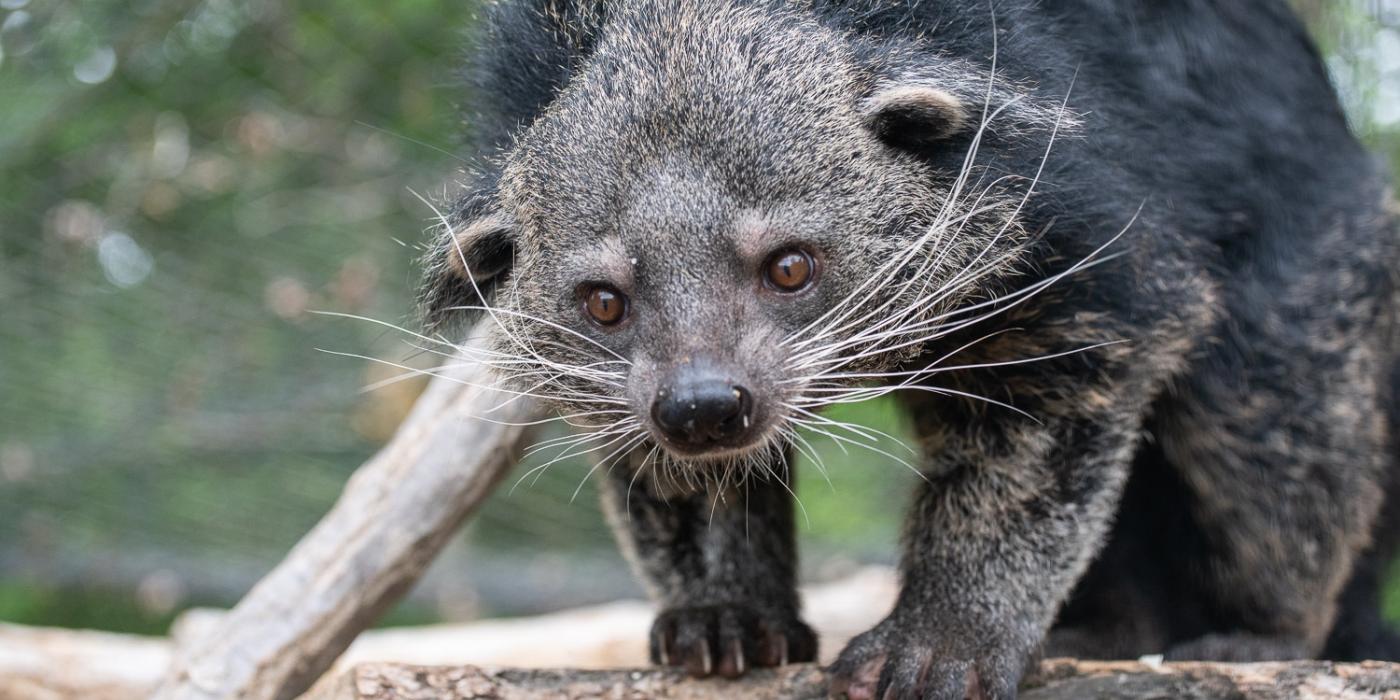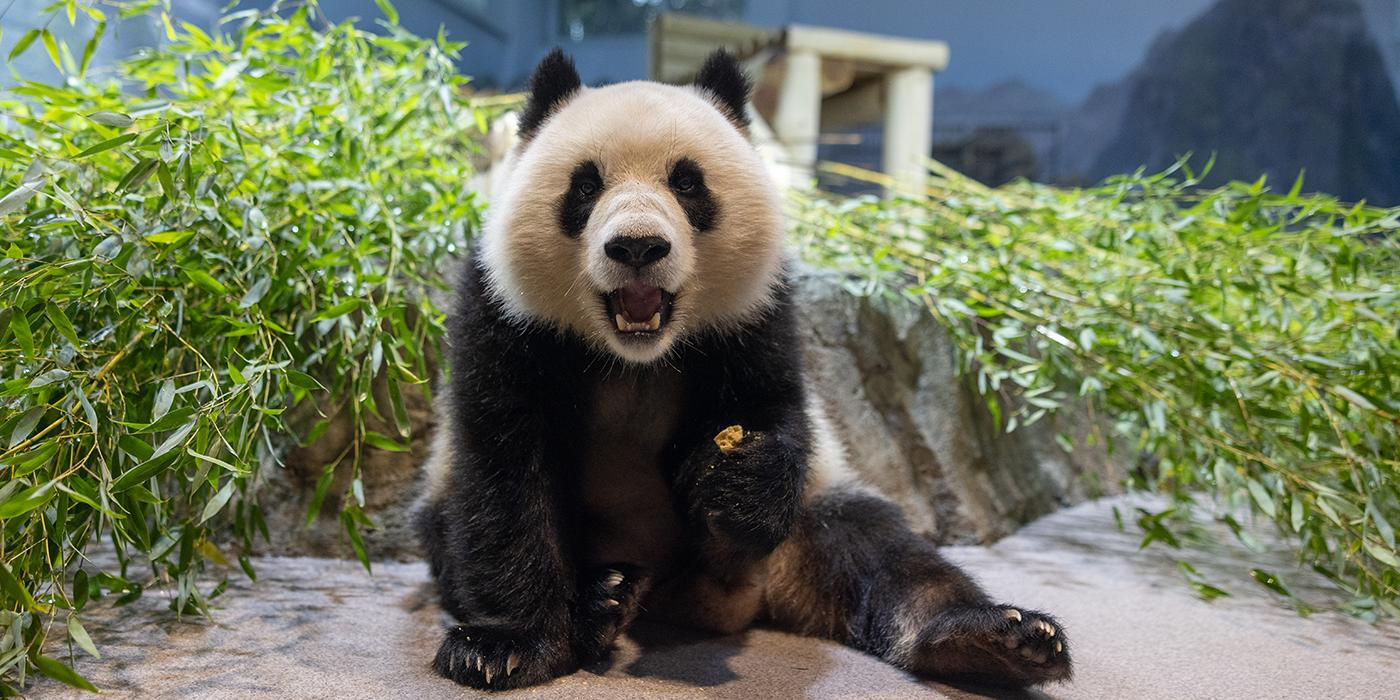How Do You Train a Cow for Checkups?
C’mon down to the Kids’ Farm and meet our moo-velous cattle: Holstein Magnolia (a.k.a. Maggie) and Hereford Willow! These sweet and charming cows are also incredibly intelligent—they have learned medical behaviors that enable our animal care team to closely monitor their health. Keeper Nikki Maticic shares some udderly fascinating training techniques in this Q+A. This update was written by communications intern Sophia Kestell.
Why do you train the cows?
With Maggie being just over 2,000 pounds and Willow just shy of 1,700 pounds, our cows are not small ladies! One of the ways that we work with these sizable animals safely is by training them to do behaviors that help us take care of them.
Training is also a fantastic way for keepers to create and maintain the important bonds between us and the animals we care for. The positive relationships we have built with Maggie and Willow over the years means we are able to view them up close, monitor their health and work closely with our veterinary team to administer treatments.
Having that trusting relationship helps make diagnostic exams and medical procedures easier, faster and less stressful, not only for the cows but also for our animal care team!
How do you train these behaviors?
With lots and lots of repetition, snacks, and trust! In any given training session, we use a combination of verbal cues, training tools and hand signals to communicate which behavior we are asking the cows to do. Whenever we train a new behavior, we take it slow and steady, moving at their pace.
All of the training that we do with the cows involves positive reinforcement, a type of operant conditioning where we pair a behavior with a reward.
Video | Holstein cow Magnolia touches her nose to a target, opens her mouth, backs up, holds in place, and presents her neck on her keeper's cues.
What are their rewards for participating?
The cows love receiving some of their favorite snacks as incentives for participating in training sessions. We call these ‘reinforcements.’ Usually, we use hay cubes (compressed bits of hay) as their reinforcements as it is one of their favorite foods. We try to use foods that are highly preferred by the cows so that the reward is worth it when they do a behavior!
The treat portion of the cows’ diet is a bonus. We still give them a variety of vegetables every day, including carrots, beets and sweet potatoes. They also get sweet feed, browse (branches with tender shoots and leaves), grain and hay cubes, even if they do not want to participate in a training session.
There are some days where the cows may choose not to participate in training. If they don’t want to participate, they don’t have to. They just get fewer treats that day. Those instances can be helpful indicators for keepers that a cow might be feeling unwell. We keep an extra watchful eye on them on those days, just in case!
Video | During a training session, Kids' Farm keeper Nikki Maticic asks Holstein cow Maggie to present her hoof for inspection.
What behaviors are Maggie and Willow learning?
The first behavior our cows learned was how to follow a target pole—a long, plastic dowel with a tennis ball on the end. When presented with this new, interesting object, they instinctively sniff to investigate what it is! When they touch their nose to the target, we let them know they have done the correct behavior by immediately offering them a favorite treat as reinforcement.
Establishing a positive association with the target pole allowed me to ask the cows to follow the target pole, including into a large chute that is stationed on the barn’s outdoor patio. The chute is incredibly important as it allows us to safely secure the cows for medical exams. By training them to enter the chute voluntarily, it gives Maggie and Willow the choice to participate in their own health care.
During our training sessions, I work on getting the cows comfortable with me and other keepers touching their ears, sides, tails, bellies, udders and legs. Another behavior we train our cows to do is lift their hooves so we can inspect them for any cracks or debris. Maggie and Willow have made excellent progress with this behavior!
After we do chute training, we work on their other behaviors, including, a ‘back up’ cue and opening their mouths voluntarily so we can get a good look at their teeth. Maggie and Willow are also working on targeting their noses to a keeper’s hand and presenting their necks for voluntary blood draws.
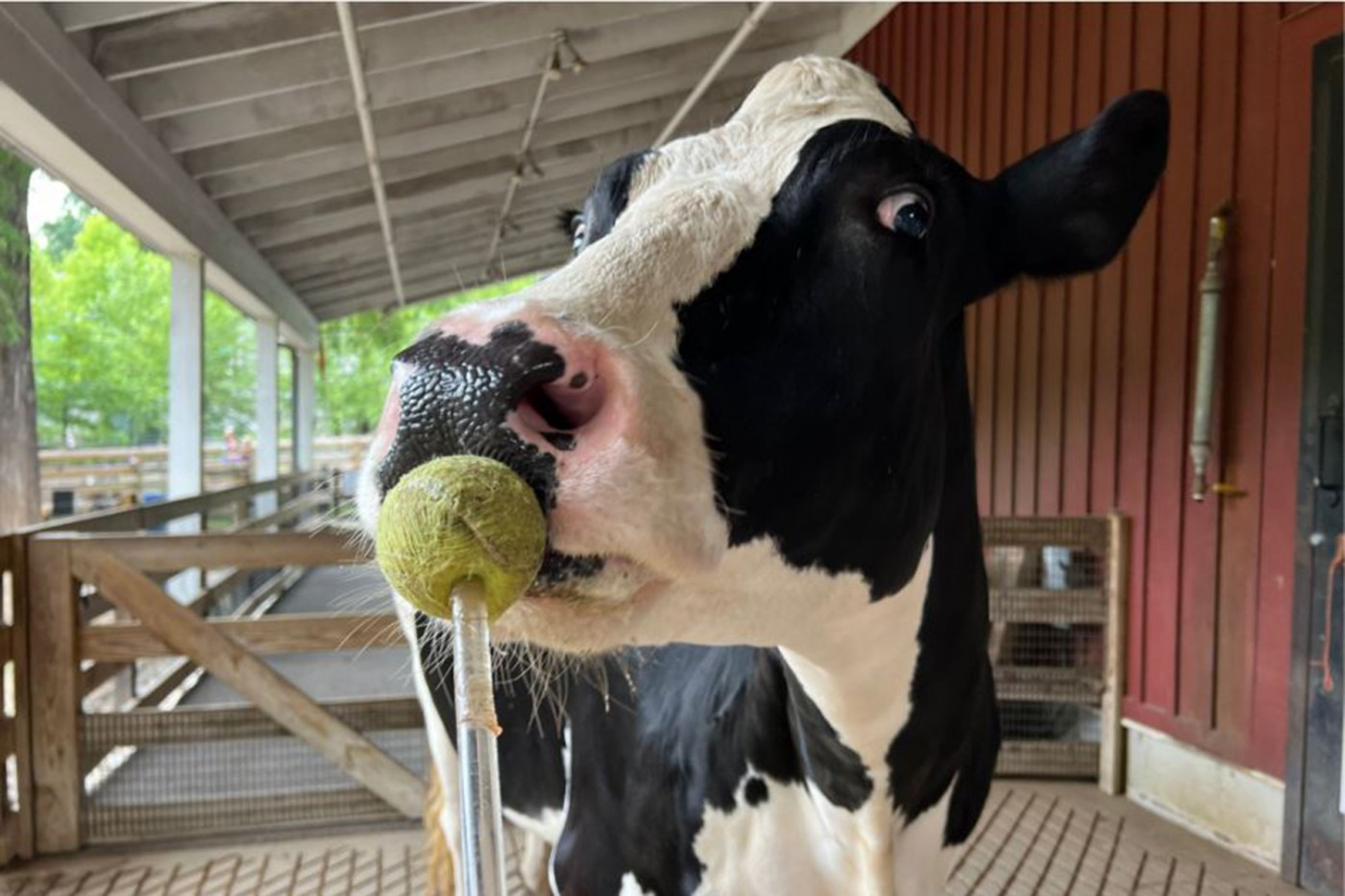
How often do you train the cows?
Although I would love to train the cows every day, we also have alpacas, miniature donkeys, goats and chickens to care for at the Farm—and they all participate in training sessions, too! Usually, I do at least two training sessions a week with each cow.
Both Maggie and Willow are eager to participate. Whenever they see me carrying their target pole, they quickly come up to the patio. Seeing how excited they are to participate in a training session shows me how much they enjoy interacting with me, practicing their behaviors and, of course, getting some well-deserved hay cube treats!
How long does it take to train this behavior?
It depends on the individual animal and their level of comfort with the training! Some behaviors do not take many sessions to train—such as asking an animal to open its mouth or touch its nose to a target. Other behaviors—such as lifting hooves on cue, can take a lot longer.
At this point, Maggie and Willow voluntarily enter the training chute as a routine part of their training session. However, it took many months of work to get them comfortable entering the chute.
Video | During a training session, keeper Nikki Maticic asks Hereford cow Willow to follow a target into a chute. She acclimates Willow to the sound of the doors opening and closing.
Did you have to overcome any challenges?
When Willow received the COVID-19 vaccine a few years ago, she was already trained to voluntarily enter the chute on cue and was comfortable receiving exams. But after that particular procedure, for some reason she had a big setback. She wouldn’t go near the chute at all! So, we had to brainstorm a way to rebuild her trust and confidence.
We wanted her to have a positive association with the chute again. So, anytime she showed interest in it, we rewarded her. As time went on, her comfort increased, and she followed a target pole about halfway into the chute. However, she would not go in any farther. And, if I moved along the sides of the chute, she would back out.
In order to rebuild that training foundation, I moved through the behavior at Willow’s pace. Whenever she took a step forward in the chute, I reinforced that behavior with a treat. This allowed Willow to form a positive association with the chute. If she took a step back, we would pause and start over again. After eight months of training, Willow confidently entered the chute!
In the following month, we worked to get Willow comfortable with us closing the chute’s front and back gates. By the end of the year, she was ready for her annual exam and voluntarily entered the chute, where she received a routine checkup and vaccines. The following week, she went back in the chute for a practice session without hesitation!
What did that experience teach you?
Cows are very resilient creatures. You have to be patient in working with them. They need time to build trust with their keepers and their surroundings. Taking small steps and offering lots of positive reinforcement are paramount to their success!
Maggie and Willow have shown me the importance of building a solid training foundation. I think of our training sessions like a bank account. Every time they do the correct behavior asked of them, they receive a treat as an incentive—a positive experience. This is a “deposit” in our training bank.
Sometimes, we need to make a ‘withdrawal’, say, when we need to administer a vaccine. A needle stick can cause temporary discomfort or nervousness, even though the cows receive lots of treats and praise for their participation.
The key is to have lots of positive ‘deposits’ in our training bank so that even when we have to do ‘withdrawals’, we have a lot of positive history to fall back on. This can help reduce any post-exam nervousness, too. In the next training session, we can start wherever the cow feels most comfortable.
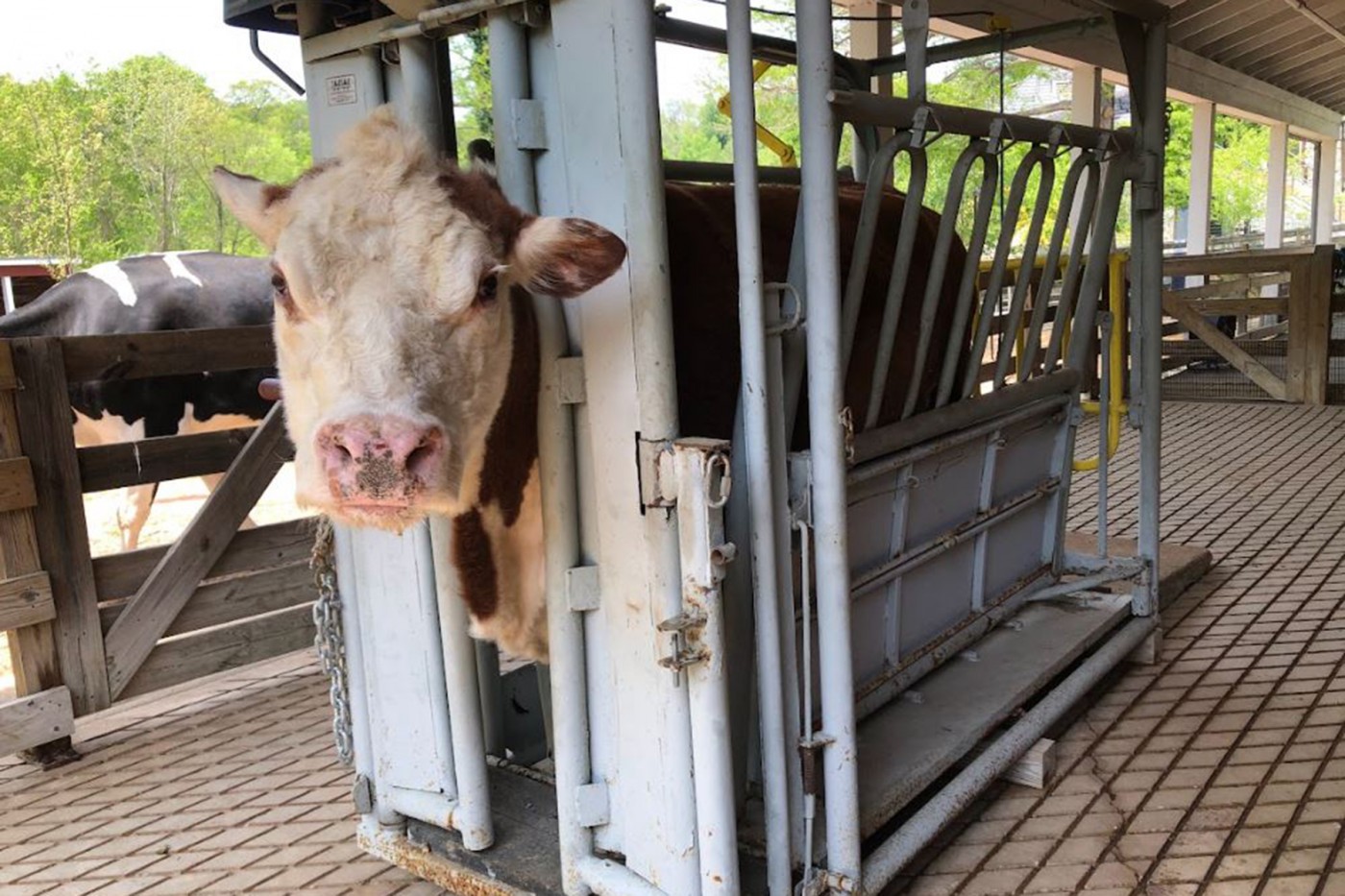
How do Maggie and Willow’s learning styles differ?
Maggie is quick to pick up on new behaviors and is not as cautious as Willow when it comes to investigating new things. It’s been a blast training them over the years and seeing them develop their training styles.
We started working with both of them when they were about a year old. Younger cows can be a bit easier to train, since they are naturally curious and willing to investigate new things! It can be beneficial, too, to get them into the routine of a training session while they are young.
However, that’s not to say an older cow can’t learn new tricks! With our former cows, Tulip and Rose, we were able to train them to voluntarily enter the chute late in their lives. They took to such training quickly and did great. They gave us a lot of insight into training the cows to go into the chute. We’ve largely used the same training processes from their sessions to train Maggie and Willow!
This story appears in the August 2023 issue of National Zoo News. Curious about how we care for cows and other animals at the Zoo? Check out our How Do You Weigh Animals at the Zoo blog! And, don’t miss A Day In The Life of a Kids’ Farm Keeper.
Related Species:

